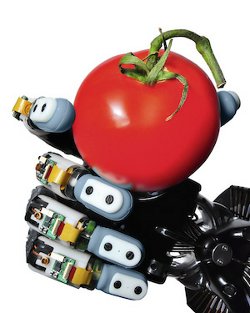
USC robot gains sense of touch
By Design Engineering Staff
General engineering Robotics sensorTactile sensor allow robotic fingers to identify materials better than humans.
Researchers at the University of Southern California’s Viterbi School of Engineering have demonstrated a specially designed robot that can outperform humans in identifying a wide range of natural materials according to their textures.

The robot is equipped with a tactile BioTac sensor built to mimic the human fingertip. It also used a newly designed algorithm to make decisions about how to explore the outside world by imitating human strategies. Capable of other human sensations, the sensor can also tell where and in which direction forces are applied to the fingertip and even the thermal properties of an object being touched.
Like the human finger, the group’s BioTac sensor has a soft, flexible skin over a liquid filling. In addition, the skin has fingerprints to enhance its sensitivity to vibration. As the finger slides over a textured surface, the skin vibrates in characteristic ways. These vibrations are detected by a hydrophone inside the bone-like core of the finger.
Developed and built by biomedical engineering Professor Gerald Loeb and recently graduated doctoral student Jeremy Fishel, the robot can distinguish between 117 common materials gathered from fabric, stationery and hardware stores. When confronted with one material at random, the robot could correctly identify the material 95 percent of the time.
Loeb and Fishel are partners in SynTouch LLC, which develops and manufactures tactile sensors for mechatronic systems that mimic the human hand. Founded in 2008 by researchers from USC’s Medical Device Development Facility, the start-up is now selling their BioTac sensors to other researchers and manufacturers of industrial robots and prosthetic hands.
Robots Get A Feel For The World from USC Viterbi on Vimeo.
